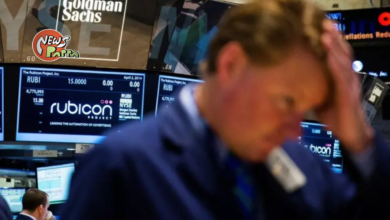The S&P 500 rebounded 0.4%, ending its 4-day losing streak.

S&P 500 Index Climbs:
On the first trading day of the last week of September, the S&P 500 index rebounded, reversing its substantial losses earlier in the month.
Market Reversal:
The historic S&P 500 index saw an increase of 17.38 points, equivalent to 0.4%, reaching 4337.44 points. Meanwhile, the Nasdaq Composite Index also climbed, gaining 59.51 points or 0.45%, while the S&P 500 index’s counterpart, the Dow Jones Industrial Average, saw an increase of 43.04 points, or 0.13%. These gains put an end to a four-day losing streak for all three major averages.
Rising Treasury Yields:
Notably, the 10-year U.S. Treasury yield experienced a 10 basis point rise, reaching 4.54%, marking its highest level since 2007 when it reached 4.57%. This upward trend in Treasury yields had been a factor affecting the S&P 500.
Market Performance:
3M, despite being one of the S&P 500 index components, emerged as the poorest-performing Dow component, suffering a 2.32% decline.
However, among the 11 historical index stocks, 8 were in positive territory, with the energy sector posting a notable rise of 1.3%.
Amazon’s Investment:

In a significant development, the online retail giant Amazon announced plans to invest up to 4 billion yuan in the artificial intelligence (AI) company Anthropic, causing its stock price to increase by 1.67%. Amazon’s influence is not limited to e-commerce; it also affects the S&P 500 index.
Market Challenges:
This month has been challenging for stock indexes, including the S&P 500, with the Federal Reserve signaling prolonged elevated interest rates and bond yields on the rise. The market has also grappled with surges in crude oil prices and the U.S. dollar, factors that are typically associated with a seasonally weak trading month. Notably, the energy sector outperformed other S&P sectors in September, with a gain of over 2%.
September Performance:
September has witnessed the S&P 500 index dropping by nearly 4%, marking its second consecutive monthly decline since December of the previous year and one of the worst single-month performances.
In particular, growth stocks, predominantly in the tech-heavy Nasdaq, bore the brunt of this decline, with the Nasdaq falling by 5.4%—its largest monthly dip since December. The Dow Jones Industrial Average, another key market index alongside the S&P 500, also experienced a 2% drop this month.
Budget Negotiations:
Additionally, investors are keeping a close watch on the progress of Washington’s budget negotiations, which could have implications for the S&P 500.
Moody’s Investors Service issued a warning, suggesting that a government shutdown would constitute a “negative credit” event for the United States.
Semiconductor Market:
In an interesting turn of events, U.S. semiconductor stocks have reversed their course, which may have negative implications for the broader stock market, including the S&P 500.
Technical Analysis:
Andrew Addison, the author of The Institutional View, a research service specializing in technical analysis, pointed out a notable shift in the S&P Semiconductors Select Industry Index.
This index had reached its peak in both price and relative terms and has now broken an upward trend that started last October.
Bearish Indicators:
The S&P Semiconductor Select Industry Index, known for its equal-weighted composition, only managed to recover half as much relative strength from its 2020 decline compared to the broader stock market index, such as the S&P 500.
Given that this index typically serves as a leading indicator for the stock market, its failure to breach the resistance line suggests a potential pullback in the broader stock market in the coming weeks.
Market Reversal:
The S&P Semiconductor Select Industry Index is expected to enter a bear market reversal state before reaching its peak. Each reversal is signaled when the index tests and breaks through the 11-week moving average.
The most recent reversal occurred in early August when the index attempted to break this barrier but was thwarted, thus decisively ending the upward trend that had persisted since October of the previous year.
Relative Strength Concerns:
From a relative strength perspective, the S&P Semiconductor Select Industry Index displayed a rounding top at the 23-year resistance line, a contrast to many other indexes, including the S&P 500, that significantly surpassed their 2000 peaks.
Instead, this index had only recovered half of its previous strength.
Investor Advice:
In light of these developments, Addison continues to advise clients to sell semiconductor stocks and secure profits, potentially affecting stock portfolios.
Reports on U.S. Dollar and other assets:
The U.S. government has once again plunged into another shutdown crisis. What’s truly remarkable is that amidst these concerns and investors seeking refuge from risks, the safest harbor they find is in the currency of the United States: the U.S. dollar.
The U.S. dollar has, time and again, demonstrated its status as the paramount safe haven.
U.S. Treasuries have witnessed a decline, dragging the entire bond market along with them. The U.S. government’s return to a shutdown crisis underscores the potential for the fiscally extravagant United States to issue more public debt.
With the recent decision by the U.S. Federal Reserve (Fed) to maintain higher and longer-lasting interest rates, investors are hard-pressed to locate a sanctuary beyond the U.S. dollar, the preeminent global currency.
The fall of U.S. sovereign bonds has paradoxically fueled the demand for the U.S. dollar. Those who invested in U.S. dollars benefited from elevated interest rates, bolstering the U.S. dollar’s ascent. Investors now find themselves in an unparalleled situation, as the $25.5 trillion U.S.
Treasury market faces a third consecutive year of losses, besieged by concerns such as liquidity constraints, the Federal Reserve’s assertive monetary policy tightening, and mounting U.S. government debt issuance.
Andrew Ticehurst, an interest rates strategist at Nomura in Sydney, remarked, “The U.S. dollar currently boasts high interest rates, robust growth, and serves as a safe haven, forming an exceedingly potent combination. We anticipate continued strengthening of the U.S. dollar.”
The U.S. dollar spot index compiled by Bloomberg Information has surged by 1.8% this month, while other currencies that could also be viewed as safe havens have predominantly depreciated.
For instance, both the Japanese yen and Swiss franc have declined by over 2%. Global government bonds have experienced their most lackluster performance in a year this month, and gold has also seen a decline, while Bitcoin has dropped by 14% this quarter.
U.S. Treasury yields persistently reached multi-year record highs on Monday. Moody’s has sounded a warning that another shutdown could erode confidence in the U.S. government. Moody’s is the sole major credit rating agency that accords the United States the highest credit rating.
Furthermore, the yen is on the verge of depreciating by more than 10% for the third consecutive year.
The Bank of Japan (BoJ) has embraced an extremely lenient monetary policy amidst a backdrop of global monetary tightening. President Kazuo Ueda has reiterated his dovish stance, disappointing those anticipating signals of more action to terminate negative interest rates.
Also Read JP Morgan CEO: It’s a worst case scenario | Fed raises interest rates to 7%




